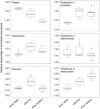The role of biofilms as environmental reservoirs of antibiotic resistance
- PMID: 26583011
- PMCID: PMC4628128
- DOI: 10.3389/fmicb.2015.01216
The role of biofilms as environmental reservoirs of antibiotic resistance
Abstract
Antibiotic resistance has become a significant and growing threat to public and environmental health. To face this problem both at local and global scales, a better understanding of the sources and mechanisms that contribute to the emergence and spread of antibiotic resistance is required. Recent studies demonstrate that aquatic ecosystems are reservoirs of resistant bacteria and antibiotic resistance genes as well as potential conduits for their transmission to human pathogens. Despite the wealth of information about antibiotic pollution and its effect on the aquatic microbial resistome, the contribution of environmental biofilms to the acquisition and spread of antibiotic resistance has not been fully explored in aquatic systems. Biofilms are structured multicellular communities embedded in a self-produced extracellular matrix that acts as a barrier to antibiotic diffusion. High population densities and proximity of cells in biofilms also increases the chances for genetic exchange among bacterial species converting biofilms in hot spots of antibiotic resistance. This review focuses on the potential effect of antibiotic pollution on biofilm microbial communities, with special emphasis on ecological and evolutionary processes underlying acquired resistance to these compounds.
Keywords: antibiotic resistance genes; aquatic ecosystems; aquatic resistome; biofilms; mobile genetic elements.
Figures

References
-
- Bagge N., Schuster M., Hentzer M., Ciofu O., Givskov M., Greenberg E. P., et al. (2004). Pseudomonas aeruginosa biofilms exposed to imipenem exhibit changes in global gene expression and β-lactamase and alginate production. Antimicrob. Agents Chemother. 48 1175–1187. 10.1128/AAC.48.4.1175-1187.2004 - DOI - PMC - PubMed
Publication types
LinkOut - more resources
Full Text Sources
Other Literature Sources

